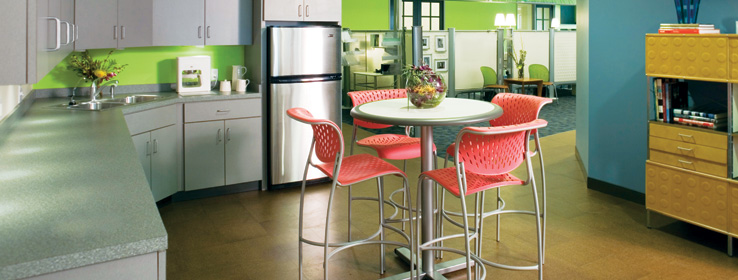A commercial interior design firm introduces sustainable building practices to a just-emerging market, coloring its walls — and the horizon — a hopeful shade of green.
Green building projects present special challenges, and that can be especially true in places where environmentally sound building practices are still in an early stage. Just ask Jill Mendoza, president of Indianapolis-based commercial interior design firm i.d.o. incorporated — Innovative Design Offerings.
In Indiana, green building has been slow to catch on for both political and practical reasons. "Electricity in the state is among the cheapest in the country," notes Mendoza. "Plus, one of the largest incinerators in the Midwest is in Indianapolis, which takes the pressure off landfills." Further hampering demand for green building is the state's lack of incentives to motivate developers. Only six projects statewide have achieved Leadership in Energy and Environmental Design (LEED) certification. Neighboring Illinois, by contrast, claims at least 202 certified projects, according to the U.S. Green Building Council, the organization behind the LEED rating system for sustainability in structural design, building and operation.
In fact, until recently, i.d.o. hadn't received a single request for green project work from its corporate, health-care, hospitality and educational accounts. Mendoza decided the firm couldn't afford to wait to begin its learning curve. So, from the corner office stepped a willing, trailblazer client: Mendoza herself.
Learning on the job
"We were following green building for our own professional development and wanted to learn what it would take and to test our particular market's readiness," she says. Purchasing a 5,000-square-foot single-story office building to use as their laboratory, Mendoza assigned i.d.o. project associate Donna Metallic the task of dividing staffers into teams responsible for LEED certification, public spaces, private spaces, lighting and finish materials, with the latter two teams taking the lead on color.
Color may be a visual medium but, in green building, its specification depends first upon the sense of smell. LEED certification standards for indoor air quality mandate that paints and coatings contain low-emitting materials for the benefit of those applying the finishes and occupying the space. Working with Sherwin-Williams Architectural Account Executive Shaun Williams, i.d.o. went for the lowest of the low, choosing Harmony®.
"Five to 10 years back, there were mostly pastels available in our low-VOC products," says Williams. "Today, all of our colors can be made in the low-VOC formulations, so there's the option of bright, vivid shades that invigorate spaces like i.d.o.'s."
And the designers there knew it. "The color conversations went on for months!" says Metallic. All 12 i.d.o. associates had input. "The younger associates wanted brighter colors. For a while, the palette became very blue. Then they had to pull me back because I had a lot more green," she recounts. Two directions emerged: a warm, "safer" palette featuring chocolate browns and golds, and the winner, a cooler wash of sky blue, apple green and sienna.
The clear, crisp colors infuse the space and its inhabitants with energy and inspiration, an outcome they anticipated but didn't formulate. "As designers, we're aware of the psychological aspects of color, but those were the icing on the cake, not the driving force behind our selections," says Metallic.
The designers also inherited elements from which they had to work backwards. More than two-thirds of the furniture and furnishings in the new building came from their old offices — including such signature eye-poppers as perky green conference-room chairs — earning i.d.o. LEED credits under the category "Resource Reuse." A brand-identity process undertaken in 2001 and its resulting color scheme similarly exerted influence. And new picks, such as brown-toned cork flooring, whose installation won a LEED nod under "Rapidly Renewable Materials", played right into basic color-wheel theory: opposites attract.
Opposites attract, indeed: "Even our most conservative clients like the space," says Metallic.
"When people walk in, they can't quite put their finger on what makes the space feel like it does," says Mendoza. "It's the color, combined with the fact that we're pushing 30 percent more fresh air through the system, we're emitting more natural light with colors reflecting that light, and we've used natural products so there aren't fumes in the air. Integrating all those elements, you're in a more natural environment."
Inroads are being made outside i.d.o.'s color-revved walls. A year later, the firm has one green client project on the board and a handful of RFPs outstanding. "It's still a trickle, but green building is starting to filter into our community," says Mendoza. "I'd like to think we were catalysts in that."




